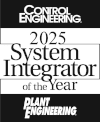A recent episode of CSIA’s podcast: Talking Industrial Automation, featured E Tech Group’s Director of Operations, Cassy Gardner. A decade of experience in engineering, sales and project management in the Life Sciences field has allowed Cassy to leverage her engineering and MBA degrees to help clients achieve their automation goals. On the podcast, Gardner discusses how she came into the field of automation, citing a professor who inspired her during her senior year and connected her to the automation professionals at Banks Integration, which later became a part of E Tech Group. Let’s look at some of the questions Cassy tackled in her podcast interview and her main talking points: Q: What kinds of trends and challenges are you seeing in industrial automation right now? Engineering labor shortages. Partners, clients, and other automation firms are having a really hard time filling positions with the right type of talent. Company visibility. We’re competing with giants like Apple and Google for the same talent, but are largely referred only by word of mouth within the automation industry. A lack of emphasis on diversity, equity and inclusion in recruitment practices. Q: What is DEI and why is it important? Diversity, Equity and Inclusion Another letter being added on is Belonging It’s about people from different backgrounds having equal opportunity to share their skills and perspective. This in turn improves design and engineering because you’re harnessing diverse points of view and skill sets. DEI measures improve the quality of a talent search. Diversity: having a wide array of perspectives and backgrounds Equity: fairness – being thoughtful in policies, procedures and vocabulary Inclusion & Belonging: going past people showing up – making sure people feel like they are a part of the organization/project/story Q: What do you mean by diversity? Engineering is a male-dominated field, … Continued

E Tech Group’s Life Sciences team was a sponsor for ISPE San Francisco’s 27th Annual Fun Day, where professionals across the automation and pharmaceutical industry got to do a different kind of networking – at golf courses and wineries. We are honored to be involved with ISPE and enjoyed seeing and having a day of fun with so many of our partners and industry colleagues. About the International Society for Pharmaceutical Engineering (ISPE) ISPE is a non-profit organization that connects pharmaceutical knowledge with manufacturing processes, including things like food sciences and pharmaceutical automation. Their mission is to support and advance pharmaceutical engineering by providing professionals with resources for innovation, networking and industry advancement. The San Francisco Bay chapter has been a particularly active chapter since its inception in the early ‘90s. E Tech Group is proud to be an active participant and sponsor in ISPE’s San Francisco Bay’s initiatives. About E Tech Group: A Nationwide Leader in Pharmaceutical Automation E Tech Group is a leader in automation innovation. Our Life Science division supports clients across the Life Sciences sector, including pharmaceuticals, cultured meats, and biologics. We share the ISPE values of supporting industry advancement and innovation with each client we serve. Offering the best in industrial data analytics, automation services and control system integration, we design, build and support custom manufacturing automation solutions that add value, security, efficiency, and scalability. If you’d like to learn more about E Tech Group’s capabilities in the pharmaceutical field, visit our Life Sciences page.

Each month E Tech Group’s internal Wellness Team promotes healthy living through a different internal “challenge” that focuses on one area of wellness. For our July we had a “Challenge for Charity.” Employees tracked their active minutes; the more activities and fitness minutes tracked the more money we would donate to Revived Soldiers Ukraine. Over the course of the month E Tech Group team members recorded over 45,000 active minutes! We are honored to contribute and support to the efforts of Revived Soldiers Ukraine.
Challenge
“If you fail to plan, you are planning to fail”. This quote by Benjamin Franklin emphasizes the importance of site surveys for industrial environments. With time, money, and resources on the line, site surveys act as a crucial first step to plan for maintenance, spare parts, upgrades, and mitigate the risk of unplanned downtime. This critical information was needed by a leading American food distributor to better understand the health of their plant’s automation infrastructure. E Tech Group was engaged to thoroughly assess their automation hardware and operational technology (OT) networks and provide a comprehensive site assessment report. This report would clearly identify risks and opportunities as well as crucial steps to upgrade and strengthen their automation infrastructure.
Solution
The customer’s plant had three buildings which included over 500 control panels. E Tech Group analyzed numerous factors and data points to determine areas of risk and opportunity across their plant. This included the lifecycle of parts that are currently being used on the production floor as well as the equipment’s life cycle positioning ranging from active to end of life. E Tech Group’s certified professionals also evaluated existing processor types and quantities across the plant and documented the customer’s OT network infrastructure.
The data collected from the site assessment was then organized and analyzed to serve as a roadmap for facility improvements. E Tech Group formulated a comprehensive, well-structured report for the customer’s management, engineering, and maintenance teams which outlined upgrade recommendations and a clear timeline to implement these upgrades based on the priority level.
Results
E Tech Group worked closely with a plant electrician to complete an on-site assessment of all control panels and OT networks in less than eight weeks. The data from the site assessment was used to provide a comprehensive report outlining automation infrastructure by area, OT network architecture, obsolescence, and recommended paths forward to modernize. The site assessment resulted in a proactive plan to reduce the customer’s likelihood of future controls hardware failures and provided a clear roadmap to strengthen their automation infrastructure.




